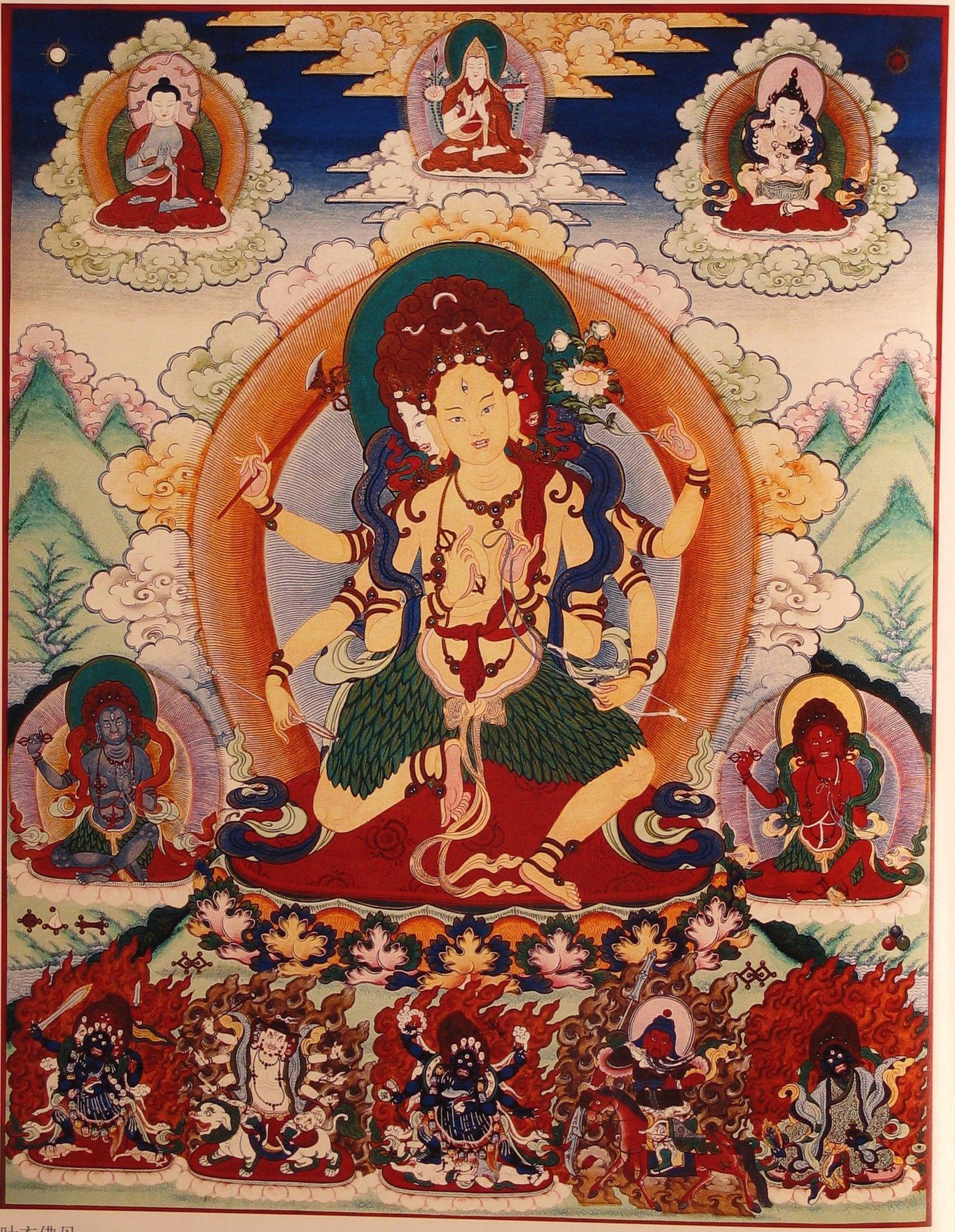Interpreting Parnashavari – Goddess of Natural Healing
Parnashavari is also known as the goddess who protects from a contagious illness. Parnashavari is a Hindu deity adopted as a Buddhist deity of diseases, worship of which is believed to offer effective protection against outbreaks of epidemics.
Parnashavari is called the Mountain Ascetic Wearing Leaves in English. Parnashavari is also known as ri tro ma, lo ma gyun ma in Tibet.
Table of Contents
The iconography of the Parnashavari
Parnashavari is a natural who is yellow in color. Parnashavari has three faces and six hands. The main face of Parnashavari is slightly peaceful and wrathful.
Parnashavari has three eyes. Parnashavari tied her hair with a snake in a topknot on the crown of the head. The red face of the Parnashavari is on the left which is in a desirous mood.
And the white face of the Parnashavari on the right is peaceful. The first pair of hands of the Parnashavari holds a gold vajra. And a vajra lasso held to the heart.
The lower body of the Parnashamvari is covered with a thatched skirt of fresh leaves which is tied with a yellow silk ribbon. With the right knee pressing on the sun disc and lotus seat she sits in a kneeling posture. Flames and a dark blue nimbus surround the entire form.
Parnashavari belongs to the Kriya class of tantra and is employed in the eradication of the contagious disease. Various lineages of practice are found in both the Nyingma and Sarma schools of Tantric Buddhism. Parnashamvari is associated with the mysterious Shavari tribe of ancient India.
Depicting Parnashavari Thanka
The thangka of Parnashavari is from the Himalayan Region. The thangka is made between 1800 – 1899 AD. Parnashavari is from Gelug and Buddhist lineage. The base of the painting is Ground Mineral Pigment on Cotton. Currently, this painting is in the Rubin Museum of Art.
Blue Buddha
Blue Buddha is at the top center of the Parnashamvari in the thangka. Blue Buddha is wearing silks and ornaments.
Chandika
Chandika is in the lower center of the Parnashamvari in the thangka. Chandika is the wrathful goddess. Chandika is yellow in color.
Achala
Achala is in the bottom left of the Parnashamvari in the thangka. According to the Atisha Tradition.
Achala is also known as Acala. Achala refers to the Immovable Wisdom Kingdom and is the best known of the Five Vidyarajas of the Womb Realm. The Sanskrit term Acala means immovable.
Acala is also the name of the eighth of the ten completion stages of the Bodhisattva path. His Siddham seed-syllable is ham. He is one of the Krodharajas, the Lords of Wrath.
He is considered as a body of metamorphosis Nirmanakaya of Vairocana Buddha. He is the symbolic protector of Buddhism, essentially incarnating Prajna Immovable for sentient beings. Acala is a principal protector of Buddhism as the destroyer of delusion and passion.
His immovability refers to that aspect of mind Buddha Nature which is forever unmoved perfectly stable and unchanging. Despite his fearsome appearance his role is to aid all beings by showing them the true essence of the teachings of the Buddha. He is leading them into perfect mental discipline.
Simhamukha
Simhamukha is on the bottom right side of the Parnashamvari in the thangka. Simhamukha is the wrathful goddess. The background of the Parnashamvara there is portrayed as a lush green landscape rich with various offerings of wish-fulfilling jewels and auspicious objects arranged as offerings petitioning the special healing favors of the deities.
Parnashavari with Mahakala Thangka
The thangka of Parnashavari with Mahakala is from China. It is made between 1800 – 1899 AD. Parnashavari with Mahakala is from Gelig and Buddhist lineage. The thangka is from the Yonghegong Palace Monastery collection.

Parnashavari with Mahakala Thangka Painting
At the top center is the Gelug founder Tsongkapa. To the left is Nageshvara Raja Buddha. On the right side is Heruka Vajrasattva.
The central figure is Body-Parnashavari, yellow in color. To the left is black mind-Parnashavari and on the right side is red speech-Parnashavari.
Along the bottom of the composition beginning on the left side is Chaturmukha Mahakala, Activity Pehar, Shadbhuja Mahakala, Guan Yu, and Shanglon Mahakala.
Depicting Buddhist Deity Parnashavari Thangka
The thangka of Buddhist deity Parnashavari is from China. The thangka of the Buddhist deity Parnashavari is made between 1700 to 1799 AD. Buddhist deity Parnashavari is from the Gelug lineage. Ground mineral pigment on cotton and fine gold is used to color it. Currently, this thangka is in the Rubin museum of art.
Lobzang Chokyi Gyaltsen
Lobzang Chokyi Gyaltsen is presented at the top center of the thangka Lobzang Chokyi Gyaltsen is wearing monastic robes and a yellow cap contrasted against a pink aureola. Lobzang Chokyi Gyaltsen is typical in appearance.
He performs the Dharma Teaching mudra (gesture) holding a vajra and bell with the two hands at the heart. He is richly attired in silk brocades. He is resting on a cushion with an ornate backrest.
Shadbhuja Mahakal
Shadbhuja Mahakala is presented at the bottom center of the thangka. Shadbhuja Mahakala is holding various wrathful objects. He stands above the white supine form of elephant-headed Ganapati.
Shadbhuja Mahakala is completely surrounded by the raging fires of pristine awareness.











